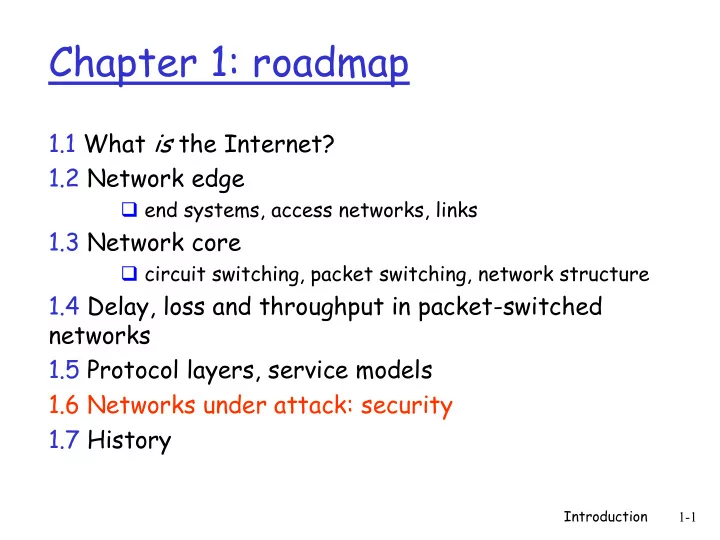

Chapter 1: roadmap 1.1 What is the Internet? 1.2 Network edge � end systems, access networks, links 1.3 Network core � circuit switching, packet switching, network structure 1.4 Delay, loss and throughput in packet-switched networks 1.5 Protocol layers, service models 1.6 Networks under attack: security 1.7 History Introduction 1-1
Network Security � The field of network security is about: � how bad guys can attack computer networks � how we can defend networks against attacks � how to design architectures that are immune to attacks � Internet not originally designed with (much) security in mind � original vision: “a group of mutually trusting users attached to a transparent network” ☺ � Internet protocol designers playing “catch-up” � Security considerations in all layers! Introduction 1-2
Bad guys can put malware into hosts via Internet � Malware can get in host from a virus, worm, or trojan horse. � Spyware malware can record keystrokes, web sites visited, upload info to collection site. � Infected host can be enrolled in a botnet, used for spam and DDoS attacks. � Malware is often self-replicating: from an infected host, seeks entry into other hosts Introduction 1-3
Bad guys can put malware into hosts via Internet � Trojan horse � Worm: � Hidden part of some � infection by passively otherwise useful receiving object that gets software itself executed � Today often on a Web � self- replicating: propagates page (Active-X, plugin) to other hosts, users � Virus Sapphire Worm: aggregate scans/sec in first 5 minutes of outbreak (CAIDA, UWisc data) � infection by receiving object (e.g., e-mail attachment), actively executing � self-replicating: propagate itself to other hosts, users Introduction 1-4
Bad guys can attack servers and network infrastructure � Denial of service (DoS): attackers make resources (server, bandwidth) unavailable to legitimate traffic by overwhelming resource with bogus traffic 1. select target 1. break into hosts around the network (see botnet) 1. send packets toward target from target compromised hosts Introduction 1-5
The bad guys can sniff packets Packet sniffing: � broadcast media (shared Ethernet, wireless) � promiscuous network interface reads/records all packets (e.g., including passwords!) passing by C A src:B dest:A payload B � Wireshark software used for end-of-chapter labs is a (free) packet-sniffer Introduction 1-6
The bad guys can use false source addresses � IP spoofing: send packet with false source address C A src:B dest:A payload B Introduction 1-7
The bad guys can record and playback � record-and-playback : sniff sensitive info (e.g., password), and use later � password holder is that user from system point of view C A src:B dest:A user: B; password: foo B Introduction 1-8
Network Security � more throughout this course � chapter 8: focus on security � crypographic techniques: obvious uses and not so obvious uses Introduction 1-9
Recommend
More recommend